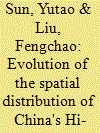| Srl | Item |
| 1 |
ID:
114083


|
|
|
|
|
| Publication |
2012.
|
| Summary/Abstract |
Spatial distribution is an important dimension of research into the development of high technology (hi-tech) industries due to the knowledgeintensive features of these industries. This paper separates the agglomeration effects and the spillover effects, and analyzes the evolution of the spatial distribution of China's hi-tech sub-industries from themid-1990s by combining the geographic concentration index (locational Gini coefficient, concentration ratio) and spatial econometrics (Moran's I). The results reveal that, firstly, most hi-tech subindustries tend to be concentrated in the eastern coastal regions of China, while there are significant spillover effects from the eastern coastal regions to the central regions. The development model based on national hi-tech industrial zones is the primary reason for industrial agglomeration, and it is the result of both government direction andmarket rules. Secondly, on the macro-level, there has been a certain amount of geographical concentration and interregional division of labor among China's hi-tech industries, but there is low intraregional specialization. Furthermore, in contrast to the findings of most of previous studies, the distribution ofChina's hi-tech industries and that of its innovation capacity share similar evolutionary trends, although they do not completely overlap.
|
|
|
|
|
|
|
|
|
|
|
|
|
|
|
|
| 2 |
ID:
124553


|
|
|
|
|
| Publication |
2013.
|
| Summary/Abstract |
We provide a sector perspective on the drivers of Chinese outward foreign direct investments (ODI) by analyzing the automotive sector over the years 2006-2011. Following the widespread literature on host-country determinants of foreign direct investments (FDI), we distinguish among economic, institutional and technological factors. We find that Chinese automotive ODI are mostly driven by the market size of host economies - a result which is robust to alternative specifications - but important non-linear effects are at work, i.e. their market-seeking investment strategies are targeted to non high-income countries. Moreover, macroeconomic stability and efficient labour markets both act as attraction factors, while the same does not seem to be true for political stability. Finally, we detect important national- and sector-agglomeration effects.
|
|
|
|
|
|
|
|
|
|
|
|
|
|
|
|